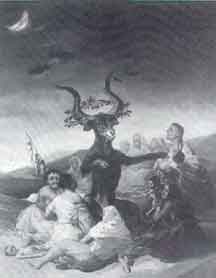

Exerpt from "Witchcraft and Neo-Paganism: From the Dark Ages to the New Age" by Brookes Alexander, C1991 SCP JOURNAL Witchcraft 1, available at www.scp-inc.org.
Gerald Gardner: Father of Modern Witchcraft
Gerald B. Gardner (1884-1964) pulled together alof those themes (and more) in the course of his lifetime. From various literary sources and personal experiences, he assembled a concept of witchcraft that has dominated the Neo-Pagan Revival.
Gardner spent most of his mature life in the Far East. He was a rubber planter and tea planter in Ceylon and Malaysia. Later he became a British customs officer, and lived for a time in India. It was a position he retained until he retired and returned to England in 1936. Living in Asia gave Gardner ample opportunity to pursue his fascination with the eccentric and the esoteric. He apparently became a nudist early in life (Adler, 1979; p. 61), and plunged with relish into the most exotic aspects of whatever culture he found himself living in.
Prior to his involvement with wicca, he had become a member of the Sufi order as well as a Co-Mason. He was also familiar with Hinduism (particularly Kali worship) as a result of his residence in India and Malaysia as a British civil servant (Kali is the Hindu goddess of death and destruction - ed.) In addition, he corresponded with Charles Godfrey Leland, author of Aradia, Gospel of the Witches. (Alba, 1989; p 29)
Gardner also knew Margaret Murray - she wrote an introduction to his first book. He was an initiate of the Ordo Temple Orientis (O.T.O.) and an acquaintance of the notorious English black magician Aleister Crowley, who clled himself "the Beast 666." In general, it is obvious that Gardner had a deep familiarity with many systems of occultism and religion. It is far from surprising under the circumstances that Gardner's story of how he "rediscovered" witchcraft should be both doubted and denied.
By Gardner's own account, he ran across a surviving coven of the "Old Religion" almost by accident. After returning to England, Gardner naturally continued his occult interests and associations. he became involved with the Fellowship of Crotona, founded by the daughter of Theosophist Annie Besant. Among the circle of occultists and eccentrics that revolved around the Fellowship, Gardner encountered some people he found different from the others, but more interesting. Among them was "Old Dorothy" Clutterbuck, a wealthy woman of the neighborhood.
According to Gardner, "Old Dorothy" turned out to be the leader of a secretive, surviving coven of the "Old Religion," and in 1939, she initiated him into what she called "wicca." Gardner could not write openly about the craft, because the witchcraft laws then in effect would have subjected him to legal penalites. Consequently, he disguised his work as fiction, and published a "novel" in 1949, titled High Magic's Aid, under the pen-name "Scire." It was presented as "a historical novel about the Craft and contained two initiation rituals, but there was no reference to the Goddess." (Adler, 1979; p.62)
The witchcraft laws were finally repealed in 1951, primarily due to the political efforts of the Spiritualist societies. Free at last to acknowledge his real affiliations, Gardner published two books under his own name: Witchcraft Today (1954) and The Meaning of Witchcraft (1959)
Gardner's version of the Craft was very different from that described by Murray. To him, Witchcraft was a peaceful, happy nature religion. Witches met in covens,led by a priestess. They worshipped two principle deities, the god of forests and what lies beyond, and the great Triple Goddess of fertility and rebirth. They met in the nude in a nine-foot circle and raised power from their bodies through dancing and chanting and meditative techniques. They focused primarily on the Goddess; they celebrated the eight ancient Pagan festivals of Europe and sought to attune themselves to nature. (adler, 1979; p, 62)
Gardner's style of witchcraft has dominated the subsequent growth of the movement. The spread and evolution of "Gardnerian wicca" is a long and complicated tale.
....Suffice it to say in brief that Gardner was charismatically effective in recruiting converts, and that some of them helped to spread the craft beyond the Britsh Isles, to both Europe and America.
One of Gardner's initiates was Raymond Buckland. Buckland imported Gardner's witdchcraft to the United States in the early 50's by establishing a coven in New York. Buckland's coven initiated others, who in turn began their own covens, and initieated still others, etc. etc.
The "counterculture" of the middle and late sixties was perfectly timed to stimulate the slowly growing wiccan movement. The counterculture's endorsement of drugs, sexual liberty, mysticism, enlightenment, self-divinization, occultism, and anti-Christianity was tailor-made to encourage the explosive growth of neo-paganism in general and neo-witchcraft in particular. The rest is history.